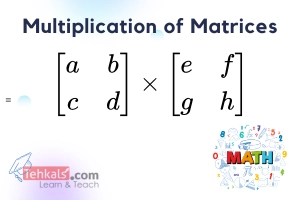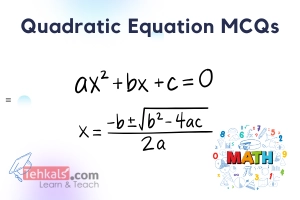Determinant of a Matrix
Published: 11 Mar 2023
Get started with the Determinant of a matrix with this beginner-friendly post, covering the basics of the Determinant of a Matrix, Singular Matrix, Non-Singular Matrix, Adjoint and Multiplicative Inverse of a Matrix.
Let’s learn how to calculate the Determinant of a Matrix.
Determinant of a Matrix
The determinant of a matrix is the scalar value or number that can be calculated from a square matrix that can provide essential information about matrix properties and behavior.
The matrix’s determinant helps us determine whether the Inverse of a Matrix exists or not, which can help us find the Systems of Linear Equations.
Symbol
The determinant of a matrix is represented in the following ways.
- Write the name of the matrix in two vertical lines. i.e., $ |A| $
- Write the det with the matrix name. i.e. $ det \ (A) \ or \ det \ A $.
Determinant of a Square Matrix
Calculate the Determinant of a Matrix
To find the determinant of a matrix, it shall be noted that the matrix should be a square matrix. Following are the methods to calculate the determinant of a matrix.
Determinant of 1×1 Matrix
Example of 1×1 Matrix
Find the determinant of $ C=[4] $.
Solution:
The determinant of $ 1 \times 1 $ matrix is itself. Thus: $ |C|=4 $
Determinant of 2×2 Matrix
Steps for Determinant of 2×2 Matrix
Step 1: Write in Standard form
Convert the matrix in standard form to find the determinant of the matrix by changing the square brackets to vertical lines with |A|.
$ |A|=\left|\begin{array}{ll}a & b \\ c & d\end{array}\right| $
Step 2: The Determinant of A is followed by:
The determinant of A equal to $ a \times d-c \times d $.
$ |A|=a d-c b $
Example:
$ A=\left[\begin{array}{cc}5 & 6 \\ -4 & 1\end{array}\right] $
Solution:
$ A=\left[\begin{array}{cc}5 & 6 \\ -4 & 1\end{array}\right] $
$ |A|=\left|\begin{array}{ll}5 & 6 \\ -4 & 1\end{array}\right| $
$ |A|=(5)(1)-(-4)(6) $
$ |A|=5-(-24) $
$ |A|=5+24 $
$ |A|=29 $
Determinant of 3×3 Matrix
Steps for Determinant of 3×3 Matrix
Step 1: Write in Standard form
Convert the matrix in standard form to find the determinant of the matrix by changing the square brackets to vertical lines with |A|.
$ |A|=\left|\begin{array}{lll}a & b & c \\ d & e & f \\ g & h & i\end{array}\right| $
Step 2: To find the $ |F| $, expand the determinant along any Row or Column. Here we expand the determinant by R1 .
$ |A|=a\left|\begin{array}{ll}e & f \\ h & i\end{array}\right|-b\left|\begin{array}{ll}d & f \\ g & i\end{array}\right|+c\left|\begin{array}{ll}d & e \\ g & h\end{array}\right| $
$ |A|=a(ei-fh)-b(di-fg)+c(dh-eg) $
Example:
$ F=\left[\begin{array}{lll}1 & 0 & 0 \\ 0 & 1 & 0 \\ 0 & 0 & 1\end{array}\right] $
$ |F|=\left|\begin{array}{lll}1 & 0 & 0 \\ 0 & 1 & 0 \\ 0 & 0 & 1\end{array}\right| $
Expand by Row 1:
$ |F|=1\left|\begin{array}{ll}1 & 0 \\ 0 & 1\end{array}\right|-0\left|\begin{array}{ll}0 & 0 \\ 0 & 1\end{array}\right|+0\left|\begin{array}{ll}0 & 1 \\ 0 & 0\end{array}\right| $
$ |F|=1 \{ (1)(1)-(0)(0) \}-0 \{ (0)(1)-(0)(0) \}+0 \{ (0)(0)-(0)(1) \} $
$ |F|=1(1-0)-0(0-0)+0(0-0) $
$ |F|=1(1-0)-0+0 $
$ |F|=1(1) $
$ |F|=1 $
Singular Matrix
Mathematically,
If $ |A|=0 $ then $ A $ is Singular Matrix.
$ D=\left[\begin{array}{cc}-3 & 6 \\ 2 & -4\end{array}\right] $
Example:
$ |D|=\left|\begin{array}{cc} -3 & 6 \\ 2 & -4 \end{array}\right| \\ $
$ |D|=12-12 \\ $
$ |D|=0 $
Thus D is a singular matrix
Non-Singular Matrix
Mathematically,
If $ |A| \neq 0 $ then $ \mathrm{A} $ is Non-Singular Matrix.
Example
$ C=\left[\begin{array}{cc}3 a & -2 b \\ 2 a & b\end{array}\right] $
Solution:
$ C=\left[\begin{array}{cc}3 a & -2 b \\ 2 a & b\end{array}\right] $
$ |C|=\left|\begin{array}{cc}3 a & -2 b \\ 2 a & b\end{array}\right| $
$ |C|=3 a b-(-4 a b) $
$ |C|=3 a b+4 a b $
$ |C|=7 a b \neq 0 $
Adjoint of Square Matrix
As change the places of $ a \ and \ d $ with each other and change the signs of $ b \ and \ c $. So
$ {Adj} A=\left[\begin{array}{cc}d & -b \\ -c & a\end{array}\right] $
$ B=\left[\begin{array}{cc}-3 & -1 \\ 2 & 3\end{array}\right] $
$ {Adj} \mathrm{B}=\left[\begin{array}{cc}3 & 1 \\ -2 & -3\end{array}\right] $
$ D=\left[\begin{array}{cc}-3 & 6 \\ 2 & -4\end{array}\right] $
$ {Adj} {D}=\left[\begin{array}{rr}-4 & -6 \\ -2 & -3\end{array}\right] $
MCQs
1. |A| is called asO Determinant
O A symmetric
O Adioint
O None
Show Answer
Determinant
Explanation:
This is the way to write Determinant
2. $ |A|=\left|\begin{array}{ll}a & b \\ c & d\end{array}\right|= $
O $ a b+c d $
O $ a b+a d $
O $ abcd $
O $ a d-b c $
Show Answer
$ ad-bc $
Explanation:
In this way, find the Determinant
3. $ \left|\begin{array}{cc}-2 & 2 \\ 3 & 5\end{array}\right|= $
O 16
O $ -6 $
O $ -16 $
O None of these
Show Answer
$ -16 $
Explanation:
$ (-2)(5)-(3)(2) $
$ -10-6 $
$ -16 $
4. $ \left|\begin{array}{cc}4 & -2 \\ -2 & 1\end{array}\right|= $
O 16
O 0
O 2
O 4
Show Answer
0
Explanation:
$ (4)(1)-(-2)(-2) $
$ 4-4 $
$ 0 $
5. The determinant is a
O number
O Transpose
O Matrix
O Adjoint
Show Answer
number
Explanation:
6. $ \left|\begin{array}{cc}4 & -2 \\ -2 & 1\end{array}\right|= $
O Singular
O Non-singular
O Adioint
O None
Show Answer
Singular
Explanation:
$ (4)(1)-(-2)(-2) $
$ 4-4 $
$ 0 $
As Determinant is 0. Thus, it is singular matrix.
7. $ |A|=0 $
O Singular
O Non-singular
O Adioint
O None
Show Answer
Singular
Explanation:
When the Determinant of matrix is zero, then the matrix is singular matrix.
8. $ |A| \neq 0 $
O Singular
O Non-singular
O Adioint
O None
Show Answer
Non-singular
Explanation:
When the Determinant of matrix is not equal zero, then the matrix is Non-singular matrix.
9. If $ A=\left[\begin{array}{ll}7 & 8 \\ 3 & 2\end{array}\right] \ then \ adj \ A= $
O $ \left[\begin{array}{cc}2 & 8 \\ -3 & 7\end{array}\right] $
O $ \left[\begin{array}{cc}2 & -8 \\ -3 & 7\end{array}\right] $
O $ \left[\begin{array}{cc}7 & 8 \\ -3 & 2\end{array}\right] $
O None
Show Answer
$ \left[\begin{array}{cc}2 & -8 \\ -3 & 7\end{array}\right] $
Explanation:
In Adjoint, change the places of a and d with each other and change the signs of b and c.
10. $ A=\left[\begin{array}{ll}a & b \\ c & d\end{array}\right] \ the \ adjA \ = $
O $ \left[\begin{array}{cc}d & -b \\ -c & a\end{array}\right] $
O $ \left[\begin{array}{ll}a & c \\ d & a\end{array}\right] $
O $ a d-b c $
O All of these
Show Answer
$ \left[\begin{array}{cc}d & -b \\ -c & a\end{array}\right] $
Explanation:
In Adjoint, change the places of a and d with each other and change the signs of b and c.
11. Multiplicative inverse of $ A $ is
O AB
O B
O A
O $ A^{-1} $
Show Answer
$ A^{-1} $
Explanation:
12. $ A \cdot A^{-1}=A^{-1} \cdot A $
O I
O A
O A^{-1}
O None
Show Answer
$ I $
Explanation:
A matrix and its multiplicative inverse is equal to Multiplicative Identity “I”.
13. $ A^{-1}=\frac{1}{|A|} {adj} $ of
O B
O I
O A
O None
Show Answer
A
Explanation:
Definition of Multiplicative inverse
14. $ F^{-1}=\frac{1}{|F|} $ adj of
O A
O I
O F
O None
Show Answer
F
Explanation:
Definition of Multiplicative inverse
15. If $ A=\left[\begin{array}{cc}1 & 3 \\ 2 & -2\end{array}\right] \ then \ A^{-1}= $
O $ -\frac{1}{8}\left[\begin{array}{cc}-1 & -3 \\ 2 & 2 \end{array}\right] $
O $ -\frac{1}{8}\left[\begin{array}{cc} -2 & -3 \\ -2 & 1 \end{array}\right] $
O $ \frac{1}{8}\left[\begin{array}{cc} -2 & -3 \\ -2 & 1 \end{array}\right] $
O None of these
Show Answer
Explanation:
$ A=\left[\begin{array}{cc}1 & 3 \\ 2 & -2\end{array}\right] $
We have
$ A^{-1}=\frac{1}{|A|} \ adj of A $
$ |A|=\left|\begin{array}{ll}1 & 3 \\ 2 & -2\end{array}\right| $
$ |A|=(1)(-2)-(2)(-3) $
$ |A|=-2-6 $
$ |A|=-8 $
$ Adj \ A=\left[\begin{array}{cc}-2 & -3 \\ -2 & 1\end{array}\right] $
Now
$ A^{-1}=\frac{1}{-8} \left[\begin{array}{cc}-2 & -3 \\ -2 & 1\end{array}\right] $
Review Exercise # 1 MCQS
1. $ \left[\begin{array}{ll}0 & 0 \\ 0 & 0\end{array}\right] $ isa. An identity matrix w.r.t multiplication
b. A column matrix
c. An identity matrix w.r.t addition
d. A row matrix
Show Answer
An identity matrix w.r.t addition
Explanation:
Zero (0) is called additive identity. Thus Zero or Null matrix is additive identity matrix.
2. The matrix $ \left[\begin{array}{cc}4 & 0 \\ 0 & -12\end{array}\right] $ is
a. A scalar matrix
b. $ \quad 2 \times 3 $ matrix
c. A diagonal matrix
d. None of these
Show Answer
A diagonal matrix
Explanation:
A square matrix on which all elements are zero except diagonal elements is known as diagonal matrix.
3. If $ A=\left[\begin{array}{cc}-1 & -2 \\ 3 & 1\end{array}\right] $ , then adj A is equal to
a. $ \quad\left[\begin{array}{cc}-1 & -2 \\ 3 & 1\end{array}\right] $
b. $ \quad\left[\begin{array}{cc}1 & 2 \\ -3 & -1\end{array}\right] $
c. $ \left[\begin{array}{cc}-1 & 2 \\ 3 & 1\end{array}\right] $
d. $ \quad\left[\begin{array}{cc}1 & -2 \\ 3 & 1\end{array}\right] $
Show Answer
$ \quad\left[\begin{array}{cc}-1 & -2 \\ 3 & 1\end{array}\right] $
Explanation:
Let $ A=\left[\begin{array}{ll}a & b \\ c & d\end{array}\right] $
As change the places of $ a \ and \ d $ with each other and change the signs of $ b \ and \ c $. So
$ Adj \ A=\left[\begin{array}{cc}d & -b \\ -c & a\end{array}\right] $
4. If A$ =\left[\begin{array}{ll}2 & 3 \\ 3 & 4\end{array}\right] $ then $ A^{-1}= $
a. $ \quad\left[\begin{array}{cc}4 & 3 \\ -3 & 2\end{array}\right] $
b. $ \quad\left[\begin{array}{cc}4 & -3 \\ -3 & 2\end{array}\right] $
c. $ \quad\left[\begin{array}{cc}-2 & 3 \\ 3 & -4\end{array}\right] $
d. $ \quad\left[\begin{array}{cc}-4 & 3 \\ 3 & -2\end{array}\right] $
Show Answer
Explanation:
$ A=\left[\begin{array}{ll}
2 & 3 \\
3 & 4
\end{array}\right] $
$ A^{-1}=\frac{1}{|A|} { Adj } A $
$ |A|=\left|\begin{array}{ll}2 & 3 \\ 3 & 4\end{array}\right| $
|A|=8-9
$ |A|=-1 \neq 0 $
$ {Adj} A=\left[\begin{array}{cc}4 & -3 \\ -3 & 2\end{array}\right] $
Put the values in equation
$ A^{-1}=\frac{1}{-1}\left[\begin{array}{cc}
4 & -3 \\
-3 & 2
\end{array}\right] $
$ A^{-1}=-\left[\begin{array}{cc}
4 & -3 \\
-3 & 2
\end{array}\right] $
$ A^{-1}=\left[\begin{array}{cc}
-4 & 3 \\
3 & -2
\end{array}\right] $
5. For what value of d is the $ 2 \times 2 $ matrix $ \left[\begin{array}{cc}1 & 1.5 \\ 2 & d\end{array}\right] $ not invertible?
a. $ -0.6 $
b. 0
c. 0.6
d. 3
Show Answer
6
Explanation:
Singular matrix is also called NOT invertible.
Thus $ |A|=0 $
$ \left|\begin{array}{ll}5 & 1.5 \\ 2 & d\end{array}\right|=0$
$ 5 \times d-2 \times 1.5=0 $
$ 5d-3=0 $
$ 5d=3 $
$ d=\frac{3}{5} $
$ d=0.6 $
6. Suppose A and B are $ 2 \times 5 $ matrices, which of the following are the dimensions of the matrix $ A+B $ ?
a. $ 2 \times 5 $
b. $ 10 \times 10 $
c. $ \quad 7 \times 7 $
d. $ \quad 7 \times 1 $
Show Answer
$ 2 \times 5 $
Explanation:
For Addition of two matrices, the dimensions of the matrices must be same. Thus A+B have the dimensions $ 2 \times 5 $
7.Which of the following is the multiplicative inverse of $ \left[\begin{array}{ll}1 & 2 \\ 0 & 1\end{array}\right] $ is
a. $ \quad\left[\begin{array}{ll}1 & 2 \\ 0 & 1\end{array}\right] $
b. $ \quad\left[\begin{array}{cc}1 & -2 \\ 0 & 1\end{array}\right] $
c. $ \quad\left[\begin{array}{cc}-1 & 2 \\ 0 & 1\end{array}\right] $
d. $ \quad\left[\begin{array}{ll}1 & -2 \\ 0 & -1\end{array}\right] $
Show Answer
$ \quad\left[\begin{array}{cc}1 & -2 \\ 0 & 1\end{array}\right] $
Explanation:
$Let \ A=\left[\begin{array}{ll}
1 & 2 \\
0 & 1
\end{array}\right] $
$ A^{-1}=\frac{1}{|A|} { Adj } A $
$Let \ |A|=\left|\begin{array}{ll}1 & 2 \\ 0 & 1\end{array}\right| $
|A|=1-0
$ |A|=1 \neq 0 $
$ {Adj} A=\left[\begin{array}{cc}1 & -2 \\ 0 & 1\end{array}\right] $
Put the values in equation
$ A^{-1}=\frac{1}{1}\left[\begin{array}{cc}
1 & -2 \\ 0 & 1
\end{array}\right] $
$ A^{-1}=\left[\begin{array}{cc}
1 & -2 \\ 0 & 1
\end{array}\right] $
8. The determinant of $ \left[\begin{array}{cc}4 & -1 \\ -9 & 2\end{array}\right] $ is
a. 17
b. 1
c. $ -1 $
d. $ \quad-17 $
Show Answer
$ |A|=-1 $
Explanation:
$Let \ |A|=\left|\begin{array}{ll}4 & -1 \\ -9 & 2\end{array}\right| $
|A|=(4)(2)-(-9)(-1)
|A|=8-9
$ |A|=-1 $

- Be Respectful
- Stay Relevant
- Stay Positive
- True Feedback
- Encourage Discussion
- Avoid Spamming
- No Fake News
- Don't Copy-Paste
- No Personal Attacks



- Be Respectful
- Stay Relevant
- Stay Positive
- True Feedback
- Encourage Discussion
- Avoid Spamming
- No Fake News
- Don't Copy-Paste
- No Personal Attacks





